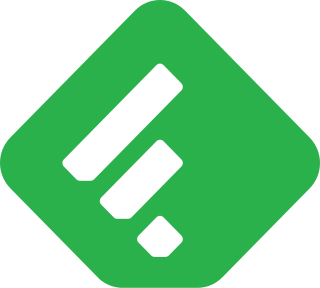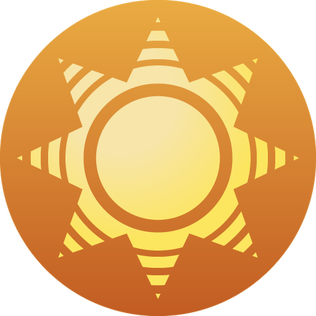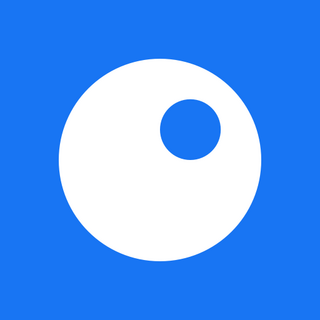
RSS is a web feed that allows users and applications to access updates to websites in a standardized, computer-readable format. Subscribing to RSS feeds can allow a user to keep track of many different websites in a single news aggregator, which constantly monitor sites for new content, removing the need for the user to manually check them. News aggregators can be built into a browser, installed on a desktop computer, or installed on a mobile device.

RSSOwl is a discontinued news aggregator for RSS and Atom news feeds. It is written in Java and built on the Eclipse Rich Client Platform which uses SWT as a widget toolkit to allow it to fit in with the look and feel of different operating systems while remaining cross-platform. Released under the EPL-1.0 license, RSSOwl is free software.

The name Atom applies to a pair of related Web standards. The Atom Syndication Format is an XML language used for web feeds, while the Atom Publishing Protocol is a simple HTTP-based protocol for creating and updating web resources.

Liferea is a news aggregator for online news feeds and podcasts. It supports the major feed formats including RSS/RDF and Atom and can import and export subscription lists in OPML format. Liferea is intended to be a fast, easy to use, and easy to install news aggregator for GTK+ that can be used with the GNOME desktop. Liferea features a script manager, in which users can add custom scripts that run whenever a certain action occurs.

In computing, a news aggregator, also termed a feed aggregator, content aggregator, feed reader, news reader, or simply an aggregator, is client software or a web application that aggregates digital content such as online newspapers, blogs, podcasts, and video blogs (vlogs) in one location for easy viewing. The updates distributed may include journal tables of contents, podcasts, videos, and news items.

Google Reader is a discontinued RSS/Atom feed aggregator operated by Google. It was created in early 2005 by Google engineer Chris Wetherell and launched on October 7, 2005, through Google Labs. Google Reader grew in popularity to support a number of programs which used it as a platform for serving news and information to users. Google shut down Google Reader on July 1, 2013, citing declining use.
Feedburner, Inc. is a web feed management service primarily for monetizing RSS feeds, primarily by inserting targeted advertisements into them. It was founded in 2004 and acquired by Google in 2007.

My Yahoo! is a start page or web portal which combines personalized Yahoo! features, content feeds and information. The site was launched in 1996 and was one of the company's most popular creations.
The following is a comparison of RSS feed aggregators. Often e-mail programs and web browsers have the ability to display RSS feeds. They are listed here, too.

LinkedIn Pulse was a news aggregation app originally developed for Android, iOS and HTML5 browsers, originally released in 2010. The app, in its original incarnation, was deprecated in 2015 and integrated into LinkedIn.

Feedly is a freemium news aggregator application for web browsers and mobile devices running iOS and Android. It is also available as a cloud-based service. It compiles news feeds from a variety of online sources for the user to customize and share with others. Feedly was first released by DevHD in 2008.

NewsBlur is an American software company based in New York City and San Francisco. It runs an online RSS news reader service accessible both online and via a free open-source mobile app for offline reading. Furthermore, the software powering NewsBlur is available and is published in an open-source application, licensed under the MIT License. Limited access to the service is free for up to 64 sites; unlimited access is available for an annual subscription fee.

Digg Reader was a news aggregator operated by Digg. The reader was released on June 26, 2013 as a response to Google Reader shutting down. The reader was web-based and also had iOS and Android applications as well as a Google Chrome extension. The beta for the reader has received mostly positive reviews. On March 26, 2018, Digg shut down Digg Reader.
The Old Reader is a web-based news aggregator that delivers website, blog, and other Internet content to a web-based inbox. The service sprang up when Google removed social features from Google Reader; the site supports social media sharing, including the ability to "like" content, and find friends via social media networks.
Feedbin is an open source feed reader. It is a web application which can be self hosted on a web server or used through a paid subscription. It has an Android client based on News+.

Inoreader is a web-based content and RSS feed reader, a cloud-based service for web browsers and mobile devices running iOS and Android. It compiles news feeds from online sources for the user in unified layout to customize and share with others. Inoreader was first released by Innologica in 2013.

QuiteRSS is a free and open source cross-platform news aggregator for RSS and Atom news feeds. QuiteRSS is released under the GPL-3.0-or-later license. It is available for Microsoft Windows, MacOS, Linux, and OS/2. QuiteRSS is also available as a portable application for Windows.

Newsboat is a free and open-source RSS/Atom feed reader for text terminals for Unix-like operating systems, released under the MIT License. It is an actively maintained fork of Newsbeuter which was abandoned in September 2017. Newsbeuter's original developers advise users to switch to Newsboat, and Newsboat's version numbers continued where Newsbeuter left off. Newsboat supports feed formats RSS and Atom and can import and export subscription lists in the OPML format. It also supports podcasting and synchronization with other news reading services.

RSS Guard is a free and open-source news aggregator for web feeds and podcasts. It is written in C++ and uses Qt, which allows it to fit with the look and feel of different operating systems while remaining cross-platform. It includes a file downloader, advanced network proxy configuration, and supports external media viewing tools.













